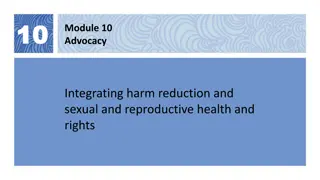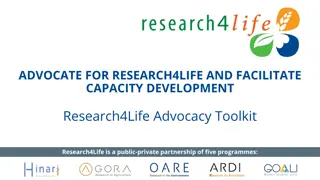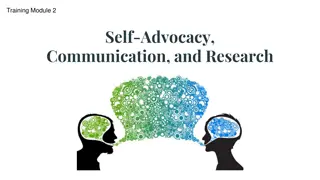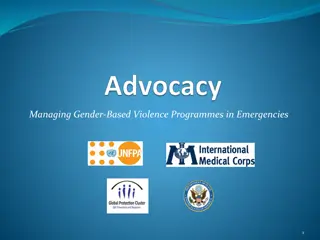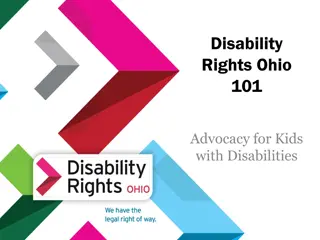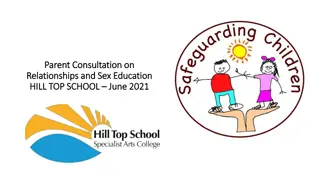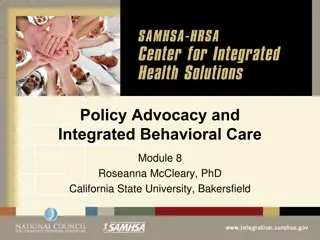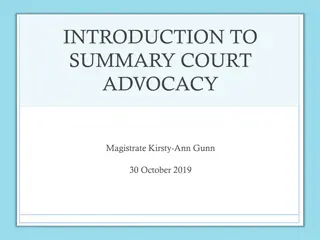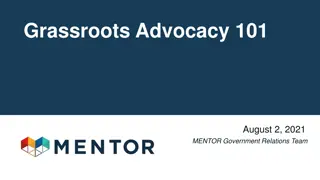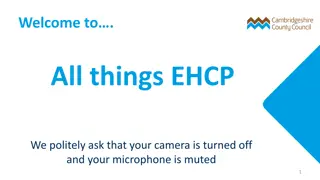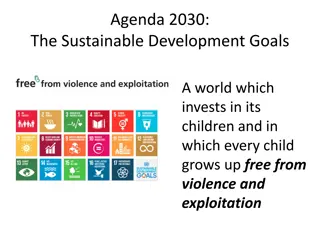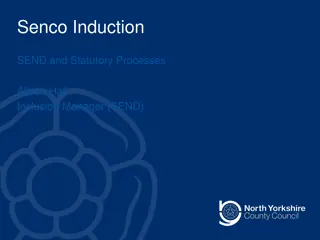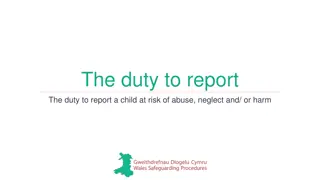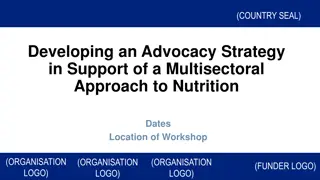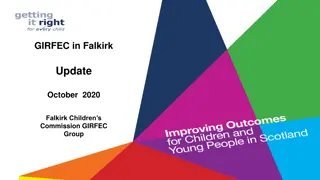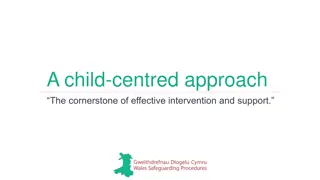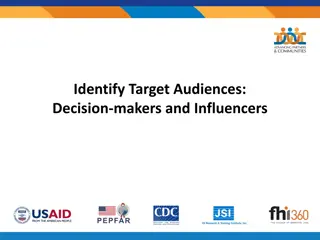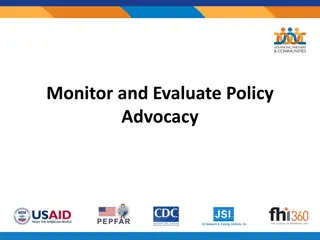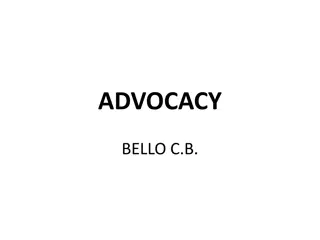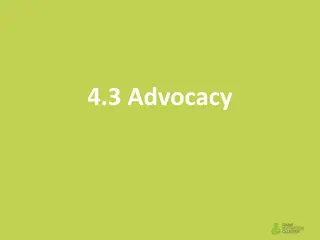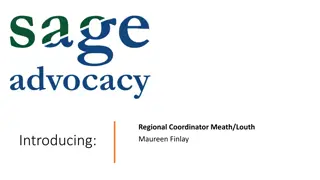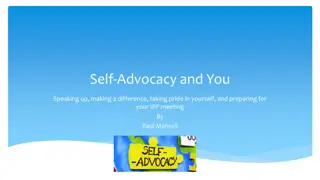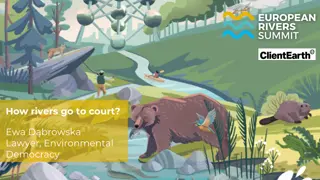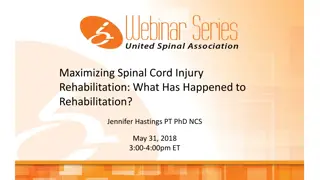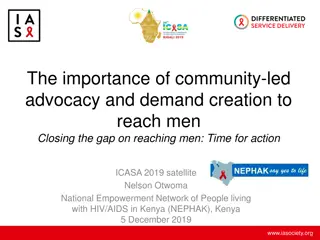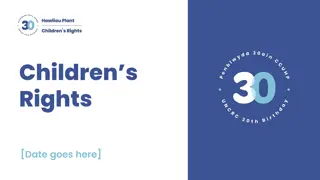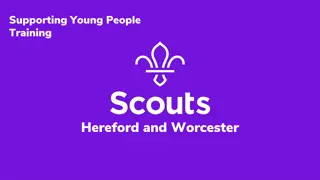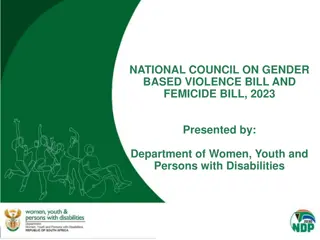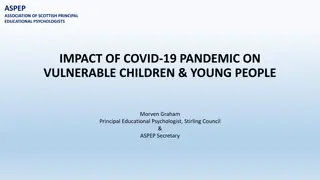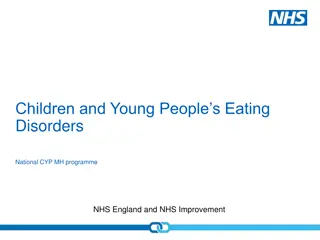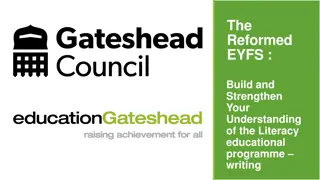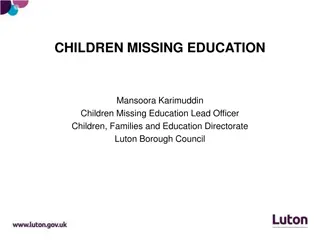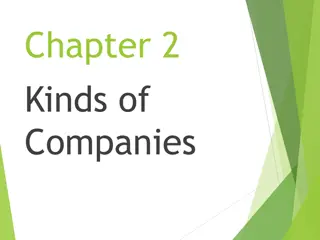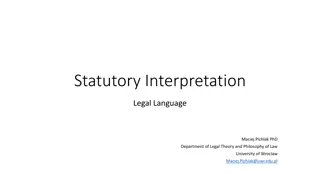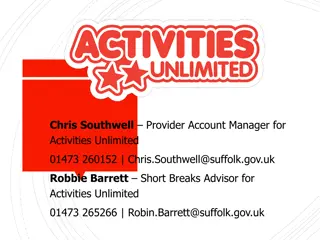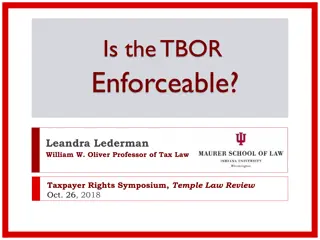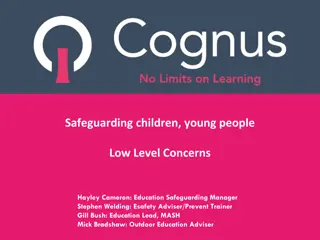Understanding the National Approach to Statutory Advocacy for Children and Young People
Exploring the significance of the National Approach to Statutory Advocacy for Children and Young People, this content delves into the role of advocates, the UN Convention on the Rights of the Child, and the fundamental principles guiding statutory advocacy. Learn about different types of advocacy, understand the rights of children, and grasp the essential elements of the National Approach.
Download Presentation

Please find below an Image/Link to download the presentation.
The content on the website is provided AS IS for your information and personal use only. It may not be sold, licensed, or shared on other websites without obtaining consent from the author. Download presentation by click this link. If you encounter any issues during the download, it is possible that the publisher has removed the file from their server.
E N D
Presentation Transcript
National Approach to Statutory Advocacy for Children and Young People What does that mean for Local Authorities and Commissioners?
Learning Outcomes By the end of the session you should be able to Understand the role of an advocate, and different types of advocacy Understand the history and where the National Approach has come from Understand the over arching principles of the National Approach Be aware of each element of the National Approach and how they all link
What is Advocacy ? Advocacy is promoting the views, wishes and feelings to ensure they are taken into account and acted upon during the decision making process that affect a child's life. It is enshrined in the United Nations Convention on the Rights of the Child. It s not working from a best interest perspective but representing their voice and being on their side.
The UNCRC Article 12 Advocacy The Convention on the Rights of the Child sets out the rights that must be realized for children to develop their full potential, free from hunger and want, neglect and abuse. It reflects a new vision of the child. Children are neither the property of their parents, they are human beings and are the subject of their own rights. The Convention offers a vision of the child as an individual and as a member of a family and community, with rights and responsibilities appropriate to his or her age and stage of development. By recognizing children's rights in this way, the Convention firmly sets the focus on the whole child. Can you name the 2 countries that did not sign up to the UNCRC?
What is advocacy? Give out the advocacy cards.. Ask learners to complete the sentence with three different endings.
The Advocates role is, at the request of the child/young person, to support them to express their wish to: STOP something CHANGE something START something
Angelsey Yns Mon Flintshire Sir y Fflint What that looks like on the ground Conwy Denbighshire Sir Ddinbych Gwynedd Ceredigion Powys Pembrokeshire Sir Benfro Carmarthenshire Sir Gaerfyrddin Neath Port Talbot Castell-Nedd Port Talbot Gwent Bro Taf Swansea Abertawe Bridgend Pen-y-bont ar Ogwr Cardiff & Vale
The difference advocacy can make I could be involved in a way I have never been able to before. People had to give me an answer instead of just ignoring me. Ellie, 12 Joe, 10 My advocate helped me to say what I wanted to say at meetings. Zara, aged 8 I know what my rights are now and that I can complain if my rights are affected. Dan, aged 14.
Principles of advocacy Person-led Independent Supporting the person to speak out Non-judgemental Empowering Confidential
Well-being statements Securing rights and entitlements Physical and mental health, and emotional well-being Protection from abuse and neglect Education, training and recreation Domestic, family and personal relationships Contribution made to society Social and economic well-being Suitability of living accommodation
Types of advocacy 2. Formal advocacy Some broader professional roles have an element of advocacy within them. The professional can support the individual to express their views and wishes while separately expressing their own professional views or judgements. 1. Peer advocacy An individual might look for advocacy support from someone who understands their situation because they ve been there or are in similar circumstances to themselves. 3. Informal advocacy An individual may seek advocacy support from someone they know on an informal basis. This type of advocacy forms part of a broader emotional relationship where the advocate may have their own strong feelings about what s best for the individual. 4. Independent Professional Advocacy An individual may be able to access an advocate whose job is to provide them with independent support to get their voice heard regardless of their own views or opinions of the situation.
Yes No Maybe Cards Exercise Go through the different types of advocacy with learners. Read through the scenario sheet and ask learners if this description is advocacy or not. The aim of this exercise is to help learners understand the different types of advocacy and that its not JUST Independent Professional Advocates that provide advocacy support.
Advocacy is Advocacy is not An advocate must Representing a person s wishes and feelings. Counselling. Be led by the person only doing what they request. Ensuring a person s rights and entitlements are being met. Support work. Represent what the person wants, regardless of their own opinions. What is Advocacy? Accessing information to ensure the person understands the process. Befriending / mentoring. Consult with the person throughout. Helping a person consider their options. Advising a person on what you think is best for them. Help the person consider all their options. Attending a meeting with someone to give them more confidence. Representing a person against their wishes. Have the time to participate as much as requested by the person. Listening to a person and acting on their direction. Talking about someone behind their back and knowing things they don t. Be friendly whilst still maintaining boundaries.
Advocacy is. recap Helping them access accurate information Helping them express their views, wishes and feelings Hearing their story and clarifying the issue Helping them to decide what they want including all potential outcomes Helping them to tell others what they want Helping them to understand outcomes Making positive endings when the advocacy relationship ends Establishing what their preferred outcome is
The National Approach to Statutory Advocacy. What do you already know? Have you already heard of NASA?
What does that mean for us? As Local Authorities and commissioners with responsibility for implementing the Approach, several changes are required which we will explore as part of this training. Including The active offer The National Standards and Outcomes Framework Local, national and regional performance monitoring and recording templates
The National Approach to Statutory Advocacy (NASA) has several overarching principles: Standardisation Accessibility for children and young people Issue based Positive outcomes and key elements: The National Standards and Outcomes Framework The Active Offer Local, national and regional performance monitoring and recording templates Wellbeing Statements
National Standards and Outcomes Framework The National Standards and Outcomes framework sets out the underpinning standards and outcomes in relation to advocacy and the outcomes children and young people can expect. It sets out a framework against which advocacy service providers and those commissioning services can ensure those standards are being achieved. Enabling us to evidence they are making positive changes to the lives of children and young people.
Children and young people who access Independent Advocacy services can expect . Good quality advocacy that is easy to find and use. Children and young people are kept safe and their privacy respected Children and young people are treated with respect and valued for their differences. Children and young people get support and have their opinions listened to. Children and young people can take part in the design, planning and rating of advocacy
National Approach to Statutory Advocacy - a history Missing Voices 2012 - Many children and young people did not know that advocacy services existed or that they had an entitlement to receive advocacy if they were being looked after by a local authority, were leaving care or were a child in need. Quote from Keith Towler, Former Children s Commissioner, cited in Missing Voices A strategic review on relation to Independent Statutory Advocacy was undertaken on behalf of Welsh Government in 2014 MEGA Group WG appointed advocacy professional to lead on development of NASA A Task and Finish Group was set up and chaired by ADSS Cymru Business case to the Minister of Health and Social Services ADSS took over lead; appointed Implementation Manager
Findings of Missing Voices 2012 Inequality of funding Reporting difference Criteria for access Major issues that children and young people didn t know about it their rights to advocacy Level of independence
Why a National Approach? Missing Voices identified a number of challenges/ issues regarding the provision of independent professional advocacy across Wales: Inconsistency and Criteria Prior to NASA, the criteria for Independent Professional Advocacy was different throughout Wales. If a child or young person has a social worker, they can now access Independent Professional Advocacy. This includes children and young people who have a care and support plan as well as those entering child protection or becoming looked after.
Post Code Lottery Inconsistency lead to a postcode lottery for children and young people. The National Approach will ensure a standardised advocacy provision, regardless of where a young person lives in Wales.
Funding Levels Lack of set funding mechanisms. Each Local Authority decides the funding level for its advocacy service. Range and Level Tool - Good quality and independent services that are easily accessible demand funding to match this. The National Approach has developed a range and level tool which can accurately calculate the funding levels required per Local Authority. It is based on an advocacy hour which takes into consideration salaries, management, administration needs, running costs, eligible populations, geography. It should ensure that all services are sufficiently funded and accessible to children and young people.
In addition to the range and level tool and in order to support the National Approach to Advocacy, the Welsh Government has provided funding of 550k to support local authorities to deliver an Active Offer.
Variable Practice No standardised training/ qualification required to become an advocate (to date) Not all advocates / providers undertake Issue Based Advocacy Service not known or used Advocacy is often only explained to children and young people by social workers, or via a leaflet given to an individual upon entering the care system
Referring to Advocacy. Anyone is able to make a referral to advocacy, a young person is also able to self refer. However, the child or young person MUST give their consent to an advocacy referral being made. The child or young person must want to have an advocacy service. They may have to have many other professional services, but advocacy is always a choice. Once a referral has been made a young person can expect to be contacted within 2 days and seen within 5 working days.
Active Offer The Active Offer is a new element to statutory advocacy provision. Missing voices reported that Advocacy services were not known or used. Just having advocacy services available isn t enough. We need to meet with children and young people to explain what these services are. Missing voices reported that. Having an Active Offer Meeting with children and young people ensures that young people know which services are available to them and what their right and entitlements are, this including Independent Professional Advocacy. The Active Offer Meeting involves a designated meeting between a child or young person and an advocate. This can happen BEFORE initial LAC review or initial CP conference. Below is the eligibility criteria: A child or young person entering the care system A child or young person entering the Child Protection arena (initial conference to take place) The young person has given consent for the meeting to take place.
The young persons social worker explains advocacy to them, and asks if they would like a meeting with an advocate for more information The young person consents the social worker refers to advocacy The advocate then completes the Active Offer Meeting
Active Offer Process Exercise Please place these cards in the right order to complete the Active Offer Process.
1 -A child/young person enters the care system, either by becoming accommodated or being placed onto the Child Protection Register 2 -The social worker informs the child or young person about advocacy and offers them a meeting ( Active Offer) with their local project. 3 - If the child/young person would like to meet with an advocate, the social worker should make a referral to the Local Advocacy project , requesting an active offer meeting to take place with the child/young person. The child/young person must consent to the referral being made.
4 - The service will: Allocate the referral to an advocate Contact the child/young person and confirm consent Agree a visit date, time and venue Inform the referrer of arrangements Proceed to visit Active Offer can take place before Initial LAC Review or before Initial CP Conference.
5 -The Active Offer Meeting takes place. 6 - Inform (with the consent of child/young person) the referrer of the type of advocacy support required and where applicable the named Independent Professional Advocate Allocate the issue within contractual time frames Proceed to provide advocacy support to child/young person until their issue has been resolved/reaches a satisfactory conclusion
7 -If the child/young person does not require advocacy support Inform (with the consent of child/young person) the referrer of the outcome.
The Active Offer Meeting Included in an Active Offer meeting should be: Explanation of Children s rights UNCRC and Article 12 Explanation of advocacy and the different types of advocacy (not just IPA) Information about the local Independent Professional Advocacy Service Information about the Children s Commissioner Information about the Meic Helpline Information about the right to complain An explanation that the advocate will record that this meeting has taken place, the outcome of the meeting (advocacy wanted/ not/ who/ how) and that this detail will be reported back to the Local Authority
Meic Helpline ProMo-Cymru successfully introduced a universal advocacy helpline the first of its kind in the UK with funding from the Welsh Government. Established in 2010, Meic is there to be someone on your side and is Wales leading one-stop information, advice and advocacy resource for children and young people up to the age of 25. A free and confidential helpline service accessible by phone, text, instant messaging and email from 8.00am to midnight, 7 days a week.
Childrens commissioner for Wales What do we do? Support children and young people to find out about children s rights Listen to children and young people to find out what s important to them Advise children, young people and those who care for them if they feel they ve got nowhere else to go with their problems Influence government and other organisations who say they re going to make a difference to children s lives, making sure they keep their promises to children and young people Speak up for children and young people nationally on important issues being the children s champion in Wales
How is the NASA & Active Offer working so far? Staggered start - official start date June 2017 last contract awarded in April 2019 WG NASA Implementation Task and Finish Group set up February 2018 to monitor and review the implementation processes National Reporting Template - being refined so we can collect statistics for future planning Eligibility Definition Active Offer has been discussed, amended and a final definition agreed. Training & Awareness Raising Sessions - Social Workers, Corporate Parents etc.
Outcomes and Impact of Advocacy Young people have much more of an understanding of their rights and entitlements and how to get help and they know what's in their care plan. The opportunity to express wishes and feelings and to be part of discussions that influences changes in their lives. Understand what is happening and how to influence decisions based on their care plan. Feel more confident and able to express their feelings and be more engaged with the people who care for them Changes their lives stability of placement, contact arrangements, education etc.
Revisit of Learning Outcomes By the end of the session you should be able to Understand the role of an advocate, and different types of advocacy Understand the history and where the National Approach has come from Understand the over arching principles of the National Approach Be aware of each element of the National Approach and how they all link Understand the implications of the National Approach for your area of responsibilities
A persons a person, no matter how small Dr Seuss - Horton Hears a Who Every child has the right to say what they think in all matters affecting them, and have their views taken seriously (Article 12 - A summary of the United Nations Convention on the Rights of the Child http://www.unicef.org.uk/Documents/Publication-pdfs/UNCRC_summary.pdf )
Other Contacts and Information TGP Cymru - https://www.tgpcymru.org.uk/ NYAS - https://www.nyas.net/ Meic Helpline - https://www.meiccymru.org/ National Standards and Outcomes Framework https://gov.wales/advocacy-standards-and-outcomes-framework- children-and-young-people



